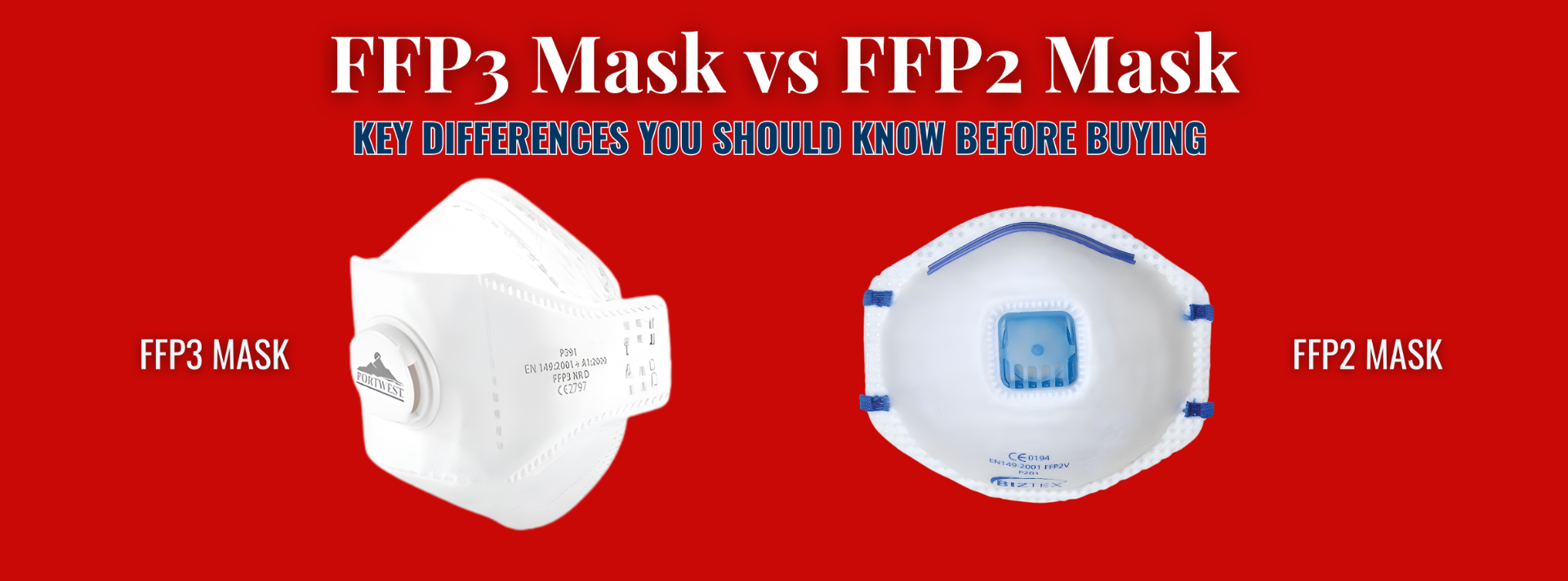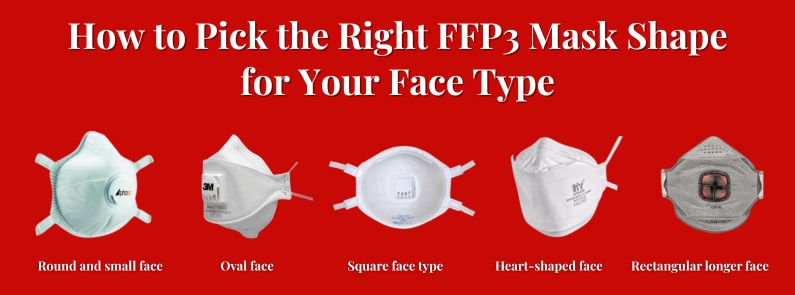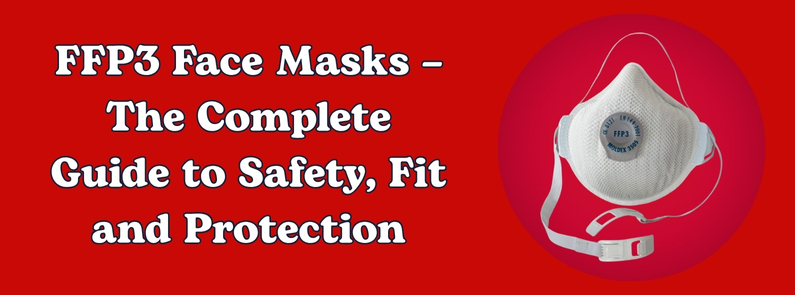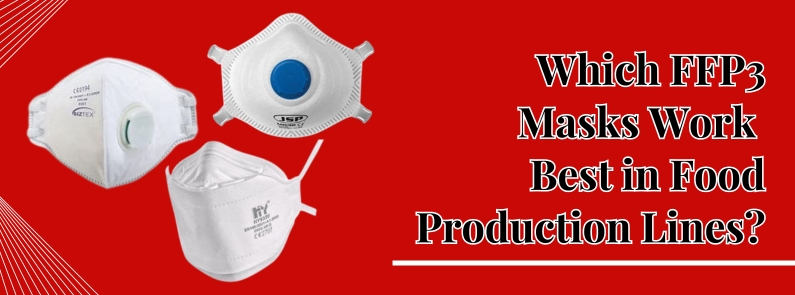
Not all face masks offer the same level of protection, yet most buyers still pick one based on price or availability rather than actual filtration performance. Whether you're working in healthcare, construction, manufacturing, or any high-risk environment, choosing the wrong mask could expose you to harmful dust, aerosols, viruses, or toxic fumes without even realising it.
According to an audit in a tertiary institution, more than half of the frontline healthcare workers unknowingly used an N95/P2 mask without adequate airborne protection. Even more concerning, FFP2 masks, commonly assumed to be good enough, were shown to allow up to five times more particle penetration compared to FFP3 models in high-risk settings.
So, how do you know when to choose FFP3 over FFP2, and is the higher price of FFP3 masks actually worth it? Let’s understand all the aspects of FFP2 and FFP3 face masks.
What Do FFP Ratings Mean?
FFP stands for Filtering Face Piece. This is a standard classifying system which is used across the UK and Europe under EN 149 to define how much airborne dust, aerosol or pathogen exposure a mask can block.
The filter masks are rated or classified into three categories: FFP1, FFP2, and FFP3, based on how much particle filtration and inward leakage they allow under the standard respirator regulation. When it comes to choosing a mask, both particle filtration and inward leakage become important aspects to consider.
- Particle filtration: It means how effectively the mask blocks airborne particles before they enter the filter material.
- Inward leakage: It refers to the amount of unfiltered air that slips through gaps between the mask and the face.
So, even with high filtration, a poor facial seal can reduce overall protection sharply.
When worn perfectly with the help of a face fit test, FFP2 reduces the exposure to air-borne particles by a factor of 10, and FFP3 reduces the risk by a factor of 20.
Here’s a table that describes FFP masks' filtration strength and maximum leakage level:
| Rating | Minimum Filtration | Maximum Inward Leakage | Typical Use |
|---|---|---|---|
| FFP1 | 80% | 22% | Low dust, DIY |
| FFP2 | 94% | 11% | Moderate dust, medical flu protection |
| FFP3 | 99% | 5% | Hazardous particles, toxic exposure |
Filtering facepieces provide protection against:
- Aqueous oily smoke
- Smoke
- Fine particles
These masks do not provide protection against gases or vapours and are not suitable for wear in environments with oxygen-deficient atmospheres, heavy chemical spills, and high heat, open flames, or molten metals.
FFP2 Mask: Protection Level and Use Cases
Key Details About FFP2 Masks:
- Particle Filtration Efficiency: at least 94%
- Total Leakage: Max 11%
- OEL Transgression: 10x value
- Filters Particles: Firm and fluid deleterious kinds of dust, smoke, or aerosols, and even fibrogenic particles
- Use Cases: Industrial, healthcare and commercial workplaces where exposure risk sits below hazardous or toxic levels.
Top FFP2 Masks: 3M Aura 9322+FFP2, Portwest P200 FFP2 Dust Mist Respirator, and 3M Particulate Respirator FFP2 Valved 8322
The FFP2 protection class masks are suitable for environments where harmful or mutagenic particles are present in the breathing air. The respirator masks in this category can effectively block 94% of the air-borne particles measuring up to 0.6 μm and can be used in environments transgressing the OEL upto the maximum of 10x concentration. The same can be applied to the TRK (technical reference concentration) value.
It is commonly compared to the N95 standard, but EN-certified FFP2 models undergo additional testing, including clogging resistance and total inward leakage assessment. This makes them more reliable for consistent daily wear in moderate-risk environments.
FFP3 Mask: Protection Level and Use Cases
Key Details About FFP3 Masks:
- Particle Filtration Efficiency: at least 99%
- Total Leakage: Max 5%
- OEL Transgression: 20x value
- Filters Particles: Poisonous and harmful dust, smoke, and aerosols, including oncogenic and radioactive particles or pathogens such as viruses, bacteria and fungal spores.
- Use Cases: All workplaces with high-risk environments where exposure involves toxic dust, fine aerosols or hazardous biological agents.
Top Masks: 3M Aura 9332+FFP3, Moldex 3505 P3/FFP3, and Alpha 303v FFP3
FFP3 masks provide the maximum protection from breathing air pollution as they effectively filter out 99% of particles measuring up to 0.6 μm with a total leakage of maximum 5%. The FFP3 mask has 20x OEL, meaning it can be worn in environments where airborne concentrations are up to 20 times higher than the legal limit. Masks in this protection class can effectively filter poisonous, oncogenic, and radioactive particles.
Overall, FFP3 masks are not everyday-use respirators. They are selected specifically for hazardous or life-threatening exposure risks where maximum filtration and a tight facial seal are non-negotiable.
FFP3 vs FFP2 Mask: Key Differences
Both FFP2 and FFP3 masks fall under the same EN 149 respiratory protection standard, but their performance varies significantly once placed in real working conditions. Here are the key differences between FFP3 and FFP2 masks:
| Feature | FFP2 Mask | FFP3 Mask |
|---|---|---|
| Filtration Efficiency | ≥94% | ≥99% |
| Maximum Inward Leakage | 11% | 5% |
| OEL Rating | Up to 10× OEL | Up to 20× OEL |
| Typical Use | Construction dust, routine healthcare | Asbestos, hazardous particles, AGPs |
| Breathability | Easier airflow | Slightly more resistance |
| Cost | Lower | Higher |
Which One Should You Buy?
To streamline the decision-making between FFP2 and FFP3 masks, here’s what you can consider:
- Use FFP2 when exposure is moderate, particles are non-carcinogenic, and budget or comfort are major factors.
- Choose FFP3 when certainty in protection matters more than cost or comfort, and when exposure risk is high or clearly defined.
Also, most models in both categories come in valved and non-valved versions. A valved mask filters the air you inhale but lets your exhaled air escape unfiltered. A non-valved mask filters both inhalation and exhalation, which makes it a better fit for healthcare settings, shared indoor workspaces, or situations where you must protect others, too.
So, if it’s about comfort and personal protection, go valved, and if you’re around others or required to comply with strict safety protocols, go non-valved.
Conclusion
Choosing the right mask is necessary because the right one can provide the right level of protection without busting your monthly budget. FFP2 masks offer a reliable defense for moderate risk environments, while FFP3 masks provide a crucial safety margin in high-hazard or legally controlled settings.
If you are still confused, match the mask to the worst-case exposure, not the average one. It’s easier to tolerate a mask that’s slightly over-engineered than to regret one that wasn’t protective enough. At Respirator Shop, you can get both FFP2 and FFP3 categories, so you can pick based on filtration level, comfort fit, or valved vs non-valved preference without second-guessing.




